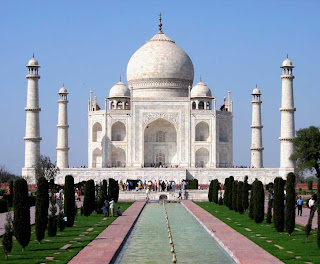
The Taj Mahal is a mausoleum located in Agra, India, built by Mughal Emperor Shah Jahan in memory of his favorite wife, Mumtaz Mahal. The Taj Mahal (also “the Taj”) is considered the finest example of Mughal architecture, a style that combines elements from Persian, Indian, and Islamic architectural styles. In 1983, the Taj Mahal became a UNESCO World Heritage Site and was cited as “the jewel of Muslim art in India and one of the universally admired masterpieces of the world’s heritage.”
While the white domed marble mausoleum is its most familiar component, the Taj Mahal is actually an integrated complex of structures. Building began around 1632 and was completed around 1653, and employed thousands of artisans and craftsmen. The construction of the Taj Mahal was entrusted to a board of architects under imperial supervision including Abd ul-Karim Ma’mur Khan, Makramat Khan, and Ustad Ahmad Lahauri. Lahauri is generally considered to be the principal designer.
History
Soon after the Taj Mahal’s completion, Shah Jahan was deposed by his son Aurangzeb and put under house arrest at nearby Agra Fort. Upon Shah Jahan’s death, Aurangzeb buried him in the mausoluem next to his wife.
By the late 19th century, parts of the buildings had fallen badly into disrepair. During the time of the Indian rebellion of 1857, the Taj Mahal was defaced by British soldiers and government officials, who chiseled out precious stones and lapis lazuli from its walls. At the end of the 19th century, British viceroy Lord Curzon ordered a massive restoration project, which was completed in 1908. He also commissioned the large lamp in the interior chamber, modeled after one in a Cairo mosque. During this time the garden was remodeled with British-style lawns that are still in place today.
Tourism
The Taj Mahal attracts from 2 to 4 million visitors annually, with more than 200,000 from overseas. Most tourists visit in the cooler months of October, November and February. Polluting traffic is not allowed near the complex and tourists must either walk from parking lots or catch an electric bus. The Khawasspuras (northern courtyards) are currently being restored for use as a new visitor center. The small town to the south of the Taj, known as Taj Ganji or Mumtazabad, originally was constructed with caravanserais, bazaars and markets to serve the needs of visitors and workmen. Lists of recommended travel destinations often feature the Taj Mahal, which also appears in several listings of seven wonders of the modern world, including the recently announced New Seven Wonders of the World, a recent poll with 100 million votes.
The grounds are open from 6 am to 7 pm weekdays, except for Friday when the complex is open for prayers at the mosque between 12 pm and 2 pm. The complex is open for night viewing on the day of the full moon and two days before and after, excluding Fridays and the month of Ramzan. For security reasons only five items—water in transparent bottles, small video cameras, still cameras, mobile phones and small ladies’ purses—are allowed inside the Taj Mahal.



nice post.
ReplyDeletethanks to owner..........
visit my site..........http://world-hotelandtourism.blogspot.in